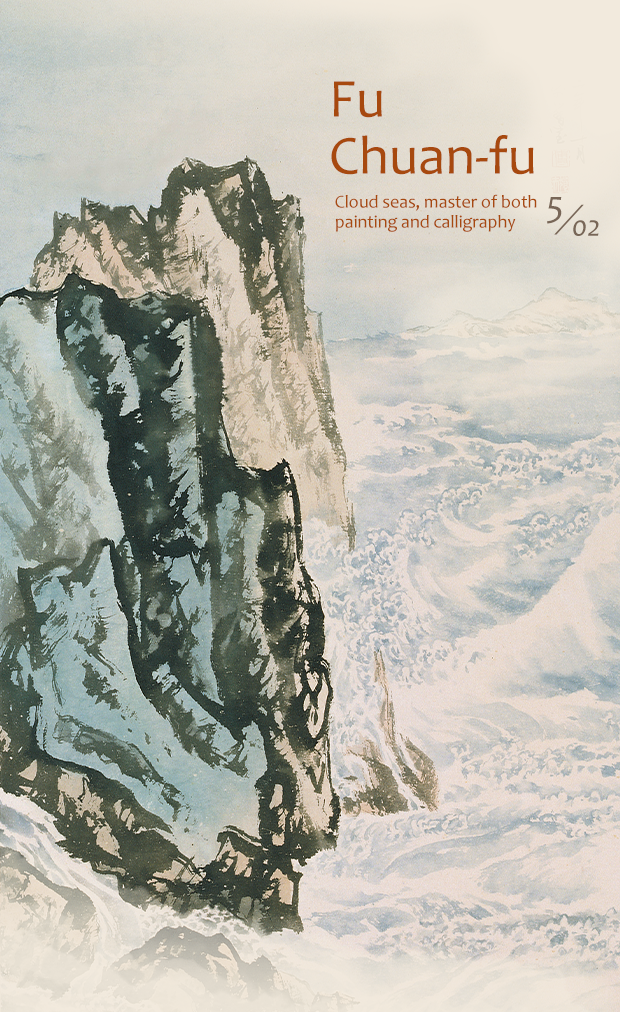

Fu Chuan-fu (1910-2007), given name Bao-qing, was also known as Wei-yi, and would later change his name to Chuan-fu to avoid being confused with Fu Baoshi, a contemporary artist. He took the professional names Jue-weng and Xuehua Cunren, and initially named his studio Xinxiang Studio, although in later life he changed the name to Feimengcao Studio. Fu, who lived to the advanced age of 97, was born in Xihu District in Hangzhou, Zhejiang Province, China. From an early age he was taught classical literature, calligraphy and seal-cutting by his father, Fu Yu, starting with the style of the Late Tang calligrapher Ouyang Xun and copying from stone inscription rubbings of famous calligraphers throughout history. Fu was determined to pass on and conserve the Chinese literati tradition and develop a firm grounding in the history of painting, calligraphy and colophon writing.
From 1936 to 1932 he studied under Wang Qianlou in the Xileng Printing Society, where he made copies of his teacher's works and ancient masterpieces. While there he specialized in landscapes and realistic paintings of local scenery, laying the foundations for his technical painting mastery. While in Nanjing in 1934, he was introduced to Xu Beihong's ideas on yixi runzhong (enriching Chinese painting with Western technique), forming the initial inspiration for his philosophy on blending East and West that increasingly came to inform his own painting style.
Fu spent the years between 1937 and 1947 in Sichuan due to the Second Sino-Japanese War, where he was inspired by the local landscape. There he studied the technique of combining complex color with ink under Chen Zhifo, and began to see a significant change in his personal style. After Fu came to Taiwan in 1949 he became fascinated by the running and cursive scripts, especially the work of Ming Dynasty painter-calligrapher Wang Duo. These new elements helped Fu develop his own lianmian cursive script characterized by unrestrained brushwork gliding effortlessly between heavy and fine strokes, running into each other depending on compositional integrity, as if in a painting. He self-deprecatingly said that his paintings were essentially calligraphy, although others praised his work for exhibiting mastery of both forms.
Fu mainly painted en plein air, traveling extensively throughout Taiwan. He took three trips along the Central Cross-Island Highway, went to Alishan on six occasions and visited places of natural beauty around the island, drinking in its vistas and climate, mists and sea-of-clouds scenery. He retired in 1960, allowing him to devote himself full-time to painting. By combining Western en plein air techniques with traditional Chinese ink painting, he created the liehucun “rift texture” and tashancun “Mt. Tashan texture” styles to depict Taiwan's rugged cliffs and rocks. Fu excelled in the “dot blotting” technique to express the drama of the crashing waves on the east coast and the “water stain” technique to depict the rapid changes in Alishan's sea of clouds, earning him the title “pioneer of Taiwanese ink painting” and acclaim for rendering both sky and seascapes with equal skill.
Fu was committed to arts education, teaching in the Political Warfare Cadres Academy (now National Defense University) and the National Taiwan College of Arts (now the National Taiwan University of Arts). He also served on the board of the Chinese Painting Institute and the Chinese Calligraphy Institute, cultivating many outstanding talents. Over the course of his life, Fu was accorded countless awards, and his unique personal style has won him approval of the highest order.
Fu Chuan-fu was a modest person, always humble in his dealings with others. He advocated a philosophy of self-restraint and confrontation avoidance, and viewed himself as “perched on the cliff of awareness, roaming within art.”
In 1990, Fu moved to San Francisco to live out his twilight years. His published works include Shanshui Huafa Chujie (First Steps in Landscape Painting Technique), Xinxiang Shi Huatan (On the Paintings of the Xinxiang Studio) and Xinxiang Shi Mantan (Ramblings of the Xinxiang Studio), in addition to collections of his own works and cursive calligraphy.
Fu Chuan-fu's friendship with the National Museum of History began in 1959, when the National Museum of Historical Artifacts and Fine Arts (the museum's original name) began its mission to reinvigorate Taiwan's moribund calligraphy scene. It invited a group of artists from China to put on a joint exhibition featuring 10 calligraphers, including Fu, who was also involved in other groups such as the “Eight Friends” and Renyin (1962). The exhibition was acclaimed at the time for pioneering new styles and for being instrumental in inspiring a new era of Taiwanese calligraphy. During this period, Fu's cursive script was highly praised for its unique style by other artists such as Wang Zhuangwei, Yao Menggu and Luo Jialun, earning a name for himself in painting and calligraphy circles and establishing his own personal style.
In 1999, when he was already living in San Francisco, Fu expressed his appreciation for the museum by donating 100 of his paintings and calligraphic works to its collection, including some of his earliest pieces and work from each stage in his career after relocating to Taiwan, representing a comprehensive and continuous overview of his career. With this generous donation, the museum now has 189 works by Fu Chuan-fu in its collection. In the same year, the museum established a scholarship in his honor to support artists committed to research and creativity in the fields of painting and calligraphy.
